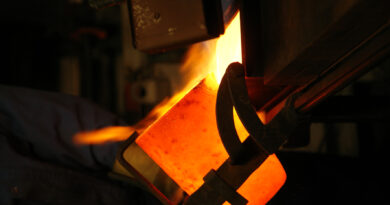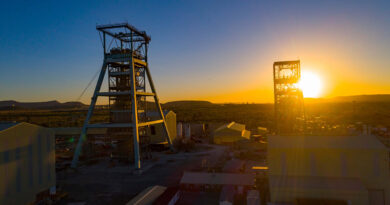Critical Metals: Australia to develop a web-based portal
Critical Metals: Australia to develop a web-based portal
The Critical Minerals Facilitation Office is cooperation with Geoscience Australia plans to develop an internet-based critical minerals portal for evaluating the geologic and economical potential of critical minerals that could be produced from Australia-mined minerals.
Critical minerals are metals and non-metals that are considered vital for the economic well-being of the world’s major and emerging economies, yet whose supply may be at risk due to geological scarcity, geopolitical issues, trade policy or other factors. Among these important minerals are metals and semi-metals used in the manufacture of mobile phones, flat screen monitors, wind turbines, electric cars, solar panels, and many other high-tech applications.
The minerals ranked as most critical by the United States, Japan, Republic of Korea, and the European Union including the United Kingdom, are as follows (ranked by Geoscience Australia based on synthesis of individual country rankings):
Rare-earth elements (REE), gallium (Ga), indium (In), tungsten (W), platinum-group elements (PGE) including platinum (Pt) and palladium (Pd), cobalt (Co), niobium (Nb), magnesium (Mg), molybdenum (Mo), antimony (Sb), lithium (Li), vanadium (V), nickel (Ni), tantalum (Ta), tellurium (Te), chromium (Cr) and manganese (Mn).
Although these minerals are critical for the world’s major industrial economies, Australia’s perspective is different in that domestic demand for most major and minor minerals is relatively small and is far outstripped by Australian production of those minerals. There are two notable exceptions, however. Phosphate and potash, used in fertilisers, are essential for Australia’s agricultural industries yet the nation is, at present, not self-sufficient in these commodities.
Australia is well known as one of the world’s leading suppliers of iron ore, coal, gold, bauxite, copper, zinc, lead, manganese, and a number of other commodities. Australia also holds large resources, or has potential for significant resources, of many of the critical minerals. Australia therefore is well placed as to be a supplier of these critical minerals to world markets.
In 2013 Geoscience Australia undertook a comprehensive assessment of Australia’s potential to supply critical minerals to global markets. This review is described below. Other studies by Geoscience Australia on critical minerals and related mineral systems, include reviews of thorium (2008) and rare-earth-element (2011) deposits in Australia, an assessment of the potential for critical minerals related to salt lake systems (potash, lithium, boron and uranium; 2013), and Australia’s potential for mafic-ultramafic intrusion-hosted Ni-Cu-PGE deposits (2016). Reports and maps are available for download by following the links.
Critical Minerals as by-products of Australian ores
Currently, many critical minerals (e.g. PGEs, REE, Cr, W, Co, Cd, Ge, Se, Te, Re) are recovered as by-products (or ‘companion metals’) from the processing of ores of major commodities such as Cu, Zn, Pb, Ni and Au.
The production of many critical minerals is strongly dependent upon the production of major commodities; as a consequence, there are opportunities to recover these elements from ores in which the critical minerals may be enriched but are not yet extracted.
There is limited information available, however, about the concentration and deportment of critical minerals in most Australian ores.
Although the data set is currently limited, the results indicate that critical minerals are enriched in some Australian ores, sufficiently so in some deposits to be potentially recoverable depending on the price of the critical mineral and the costs and viability of extraction. For example, Mississippi Valley-type and Mount Isa-type Zn-Pb ores are enriched in Ge relative to volcanic-hosted massive sulfide and Broken Hill-type Zn-Pb±Cu ores. This difference may relate to the contrasting ore fluids that form these types of deposits.
Although processed Zn concentrates are the dominant source of In worldwide, the new results indicate that the highest concentrations of In in Australian ores are within granite-related carbonate-replacement deposits such as the Renison Bell Sn mine in Tasmania. Although In correlates positively with both Sn and Cu at this and other deposits, it is likely that the host to In is chalcopyrite as one of the few In sulfide minerals (roquesite: CuInS2) is isostructural with chalcopyrite. Moreover, the limited data suggest that granite-related deposits have high concentrations of In relative to other Cu-bearing deposits such as porphyry copper deposits.
The available data suggest that the abundances of critical minerals vary in systematic patterns that can be used to predict the potential of different classes of ores as resources of critical minerals. Conversion of these geological resources into viable sources depends upon the viability and cost of recovery relative to the value of the mineral in current and future markets.
Lithium in Australia
Lithium pegmatites
The large majority of Australia’s lithium (Li) resources are contained within pegmatites, most of which are Archean in age. Available information on pegmatites is variable, making exploration targeting potentially difficult. A number of direct and proxy data sets are available that can be of assistance. These include:
Lithium prospects and occurrences in Australia
Locations of Li prospects and occurrences in Australia can be downloaded from the Australian Mines Atlas website and individual State and Territory Geological survey sites. The Mines Atlas site also includes information on Li prospects in Australia and current (to 2015) Lithium Resource figures for Australia.
Whole-rock felsic igneous geochemistry
Extensive analyses exist for felsic igneous rocks in Australia. Pegmatites are not commonly analysed, and increasingly neither is Li because of the use of fused beads made with lithium-bearing fluxes for ICP-MS analysis. Notwithstanding, available geochemical data sets are still very useful to explorationists. Firstly, older geochemical data sets often include data from AAS analysis which have reliable Li analyses. Secondly, many Li-bearing pegmatites are genetically related to and spatially associated with granites for which geochemical data does exist. Accordingly, granite geochemical data can be used to target potential regions that may contain Li-rich pegmatites. By the same token, related elements that can typically co-occur with Li, or are indicators of magmatic fractionation, are commonly routinely analysed, for example, Nb, Ta, Sn and Rb. Geochemical data for Australian rocks is available from Geoscience Australia and the State and Territory Surveys.
Surface geochemistry
The National Geochemical Survey of Australia (NGSA) project collected transported regolith samples at the outlet of large catchments covering more than 80 per cent of Australia using an ultra-low sampling density approach. Catchment outlet sediments (similar to floodplain sediments in most cases), were sampled at two depths (0-10 centimetres below the surface as well as between, on average, 60 and 80 centimetres depth). Sample analysis consisted of total element content by XRF and ICP-MS analyses, as well as acid leach analysis, e.g., aqua regia digestion, MMI ® extraction. Lithium data were collected for the aqua regia digestion and MMI ® extraction. These analyses provide a summary of Li within individual catchments across the continent, highlighting catchments with elevated concentrations that may indicate the presence of rocks with elevated Li, either exposed or under cover.
Geophysical data sets
Many Li-bearing pegmatites appear to be genetically and spatially associated with (volumetrically much larger) differentiated granites. The latter, where outcropping, can be readily identified using gamma-ray data, as these granites are commonly elevated in K2O, and U and also Th (depending on granite type). An apposite example is the Pilbara Craton where late potassic granites are very readily identified by their gamma-ray signature. Geoscience Australia and the respective State and Northern Territory Geological Surveys have systematically surveyed most of Australia over the past 40 years using airborne gamma-ray spectrometry. These surveys have been combined into a Radiometric Map of Australia, comprising of potassium, uranium and thorium grids of the continent at 100 metre resolution. The data are available for free download through the Geophysical Archive Data Delivery System (GADDS).
Lithium in salt lakes
Geoscience Australia recently produced ‘A Review of Australian Salt Lakes and Assessment of their Potential for Strategic Resources‘. The study reviewed the occurrence of Li deposits in salt lakes globally and the mineral-hydrogeological systems wherein such Li deposits can accumulate, and also assesses salt lake-related Li as well as potash, B and U prospectivity in Australia. The synthesis report is accompanied by a hydrochemical database and maps of salt lake systems prospective for Li, potash, B and U.
Critical Minerals in Australia’s salt lakes
Salt lakes formed by evaporation of surface or ground waters may in some geological settings concentrate a range of elements including Na, K, Mg, Ca, B and Li. For example, salt lakes in the Andes of South America are major sources of Li, a critical mineral. Potash (KCl) is critical to the economy of Australia due to its use in fertilisers, and yet the nation is largely dependent upon imported potash.
The assessment indicated locally high potential for potash in several large lake systems in northern Western Australia, Northern Territory and South Australia. This is indicated by historical production of potash from Lake Chandler, advanced potash projects at Lake Disappointment and Lake Mackay, and the discovery of new resources in the Karinga Creek region in the Northern Territory.
In contrast to potash, the final analysis indicated that Australian salt lakes have relatively low potential to produce commercial Li or B. This is believed to be due to a combination of geological factors including: limited hydrogeological connectivity between leachable Li-rich source rocks and the salt lakes; generally low relief of the Australian continent; and the overall very stable tectonic regime.
Geoscience Australia review of critical commodities (2013)
Critical commodities for a high-tech world: Australia’s potential to supply global demand (2013)
This report presents the first systematic and geoscientific evaluation of Australia’s range of critical commodities and of the nation’s opportunities to supply critical commodities to world markets.
For each of 34 metals, non-metals and minerals the level of opportunity or ‘resource potential’ in Australia is assessed based on: (a) the level of criticality assigned by the United Kingdom, European Union, United States of America, Japan and Republic of Korea; (b) Australia’s known resources as well as potential for discovery of new resources; (c) demand in terms of global market size; and (d) growth outlook.
Part 1 of the report presents an overview of the definition and uses of critical commodities; a summary listing of the commodities considered to be critical by the European Union, Japan, South Korea, United Kingdom and United States of America; and an evaluation of the opportunities and resource potential of critical commodities in Australia.
Part 2 is a detailed technical description of the geological settings in which critical metals, non-metals and minerals occur, and their occurrence and known resources in Australia. This section is presented within a ‘mineral systems’ framework which groups particular mineral deposit types according to their broad geological settings and processes of formation. Importantly some inferences are also presented on the potential for undiscovered resources of many of the critical commodities in Australia.
The report also includes an extensive Appendix with summaries for each of the 34 commodities of their characteristics and uses; supply data with global and Australian resources and production; and global demand data based on country import values.
The key results of the critical commodities assessment are as follows.
Commodities assessed with category one (high) resource potential in Australia are (in alphabetical order): chromium, cobalt, copper, nickel, platinum-group elements (PGE), rare-earth elements (REE), and zirconium. This assessment does not consider non-critical commodities such as ferrous metals, most base metals, and energy commodities. Australia has category one resource potential in many of these non-critical commodities.
Commodities assessed as having category two moderate to high resource potential in Australia are (in alphabetical order): antimony, beryllium, bismuth, graphite, helium, indium, lithium, manganese, molybdenum, niobium, tantalum, thorium, tin, titanium, and tungsten.
Some of the category one and category two metals and semi-metals (antimony, indium), as well as gallium, germanium, cadmium, tellurium and selenium, are primarily by-products of refining of the major commodities zinc, copper, lead, gold, aluminium and nickel. Australia’s high global ranking in resources of all of these major commodities implies that there is significant potential for new or increased production of the minor-element by-products listed above. Where recovery is currently uneconomic, opportunities may exist for improvements in mineral processing of ores to extract critical commodities as by-products.
A further conclusion of the study is that most of the critical commodities can be grouped into three families of mineral systems, as follows.
Mineral system family (1): Mafic-ultramafic igneous-related nickel, PGE, chromium and cobalt – The occurrence of these commodities is closely related to mafic-ultramafic igneous rocks derived from the mantle. Based on known resources in Australia, the continent appears to be under-represented in world-class intrusion-hosted nickel, PGE and chromium deposits despite Australia’s favourable geology for such deposits.
Mineral system family (2): Felsic igneous-related REE, tungsten, niobium, tantalum, molybdenum, beryllium, tin and bismuth – All of these metals occur (albeit not exclusively) in association with felsic igneous intrusions, in particular with highly-fractionated granitic rocks and with alkaline igneous rocks. Australia’s potential for such deposits is unrealised at present.
Mineral system family (3): Heavy mineral sand-hosted zirconium, titanium, REE and thorium – New discoveries of heavy mineral sand provinces recently in Australia attest to the potential of the continent for further delineation of major resources of heavy mineral sands and their contained critical commodities.




